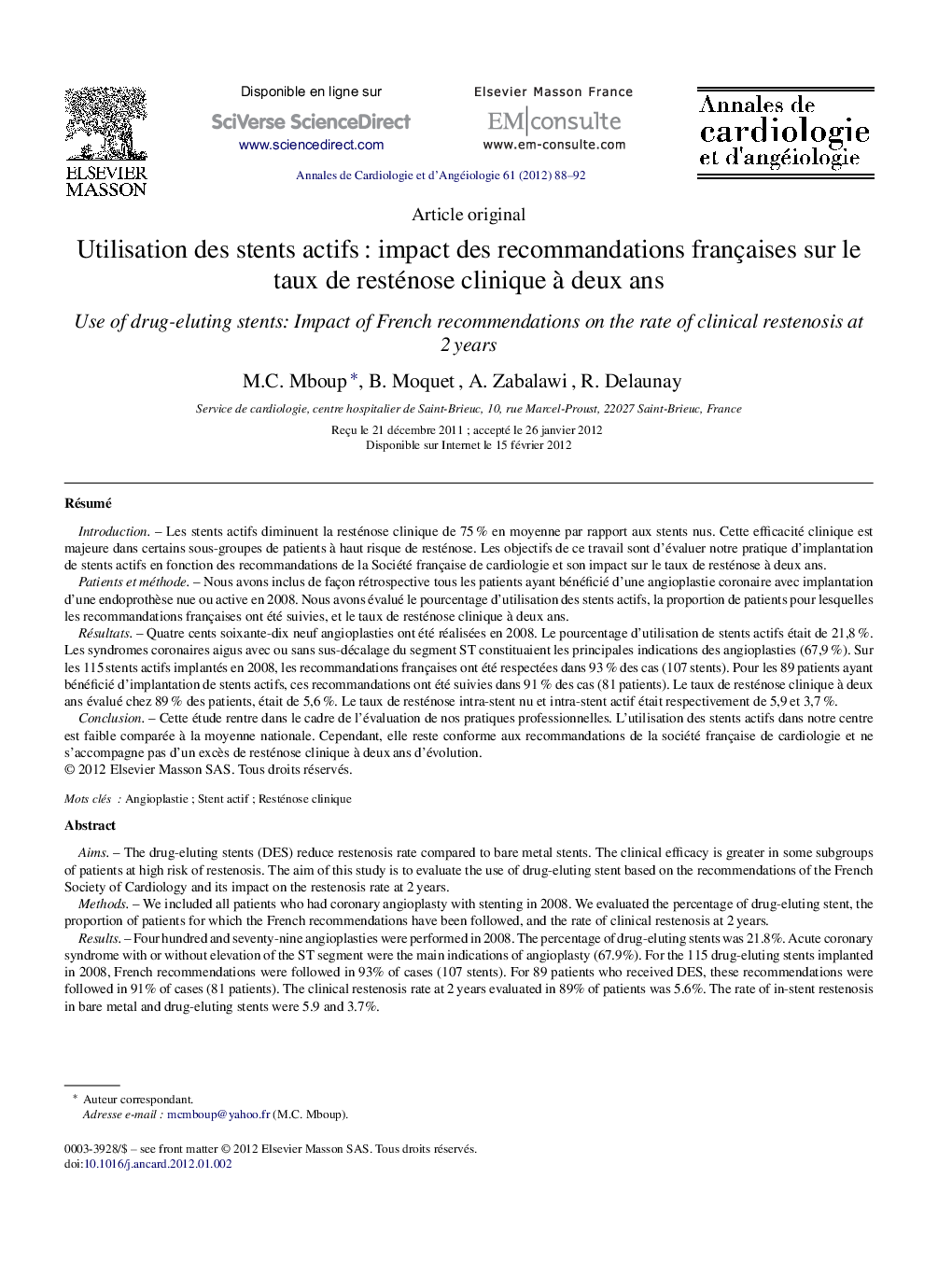| Article ID | Journal | Published Year | Pages | File Type |
|---|---|---|---|---|
| 2869055 | Annales de Cardiologie et d'Angéiologie | 2012 | 5 Pages |
RésuméIntroductionLes stents actifs diminuent la resténose clinique de 75 % en moyenne par rapport aux stents nus. Cette efficacité clinique est majeure dans certains sous-groupes de patients à haut risque de resténose. Les objectifs de ce travail sont d’évaluer notre pratique d’implantation de stents actifs en fonction des recommandations de la Société française de cardiologie et son impact sur le taux de resténose à deux ans.Patients et méthodeNous avons inclus de façon rétrospective tous les patients ayant bénéficié d’une angioplastie coronaire avec implantation d’une endoprothèse nue ou active en 2008. Nous avons évalué le pourcentage d’utilisation des stents actifs, la proportion de patients pour lesquelles les recommandations françaises ont été suivies, et le taux de resténose clinique à deux ans.RésultatsQuatre cents soixante-dix neuf angioplasties ont été réalisées en 2008. Le pourcentage d’utilisation de stents actifs était de 21,8 %. Les syndromes coronaires aigus avec ou sans sus-décalage du segment ST constituaient les principales indications des angioplasties (67,9 %). Sur les 115 stents actifs implantés en 2008, les recommandations françaises ont été respectées dans 93 % des cas (107 stents). Pour les 89 patients ayant bénéficié d’implantation de stents actifs, ces recommandations ont été suivies dans 91 % des cas (81 patients). Le taux de resténose clinique à deux ans évalué chez 89 % des patients, était de 5,6 %. Le taux de resténose intra-stent nu et intra-stent actif était respectivement de 5,9 et 3,7 %.ConclusionCette étude rentre dans le cadre de l’évaluation de nos pratiques professionnelles. L’utilisation des stents actifs dans notre centre est faible comparée à la moyenne nationale. Cependant, elle reste conforme aux recommandations de la société française de cardiologie et ne s’accompagne pas d’un excès de resténose clinique à deux ans d’évolution.
AimsThe drug-eluting stents (DES) reduce restenosis rate compared to bare metal stents. The clinical efficacy is greater in some subgroups of patients at high risk of restenosis. The aim of this study is to evaluate the use of drug-eluting stent based on the recommendations of the French Society of Cardiology and its impact on the restenosis rate at 2 years.MethodsWe included all patients who had coronary angioplasty with stenting in 2008. We evaluated the percentage of drug-eluting stent, the proportion of patients for which the French recommendations have been followed, and the rate of clinical restenosis at 2 years.ResultsFour hundred and seventy-nine angioplasties were performed in 2008. The percentage of drug-eluting stents was 21.8%. Acute coronary syndrome with or without elevation of the ST segment were the main indications of angioplasty (67.9%). For the 115 drug-eluting stents implanted in 2008, French recommendations were followed in 93% of cases (107 stents). For 89 patients who received DES, these recommendations were followed in 91% of cases (81 patients). The clinical restenosis rate at 2 years evaluated in 89% of patients was 5.6%. The rate of in-stent restenosis in bare metal and drug-eluting stents were 5.9 and 3.7%.ConclusionThe use of DES in our center is characterized by a small rate and a good compliance of the recommendations of the French Society of Cardiology. This strategy is associated with a low rate of restenosis at 2 years of follow-up.
